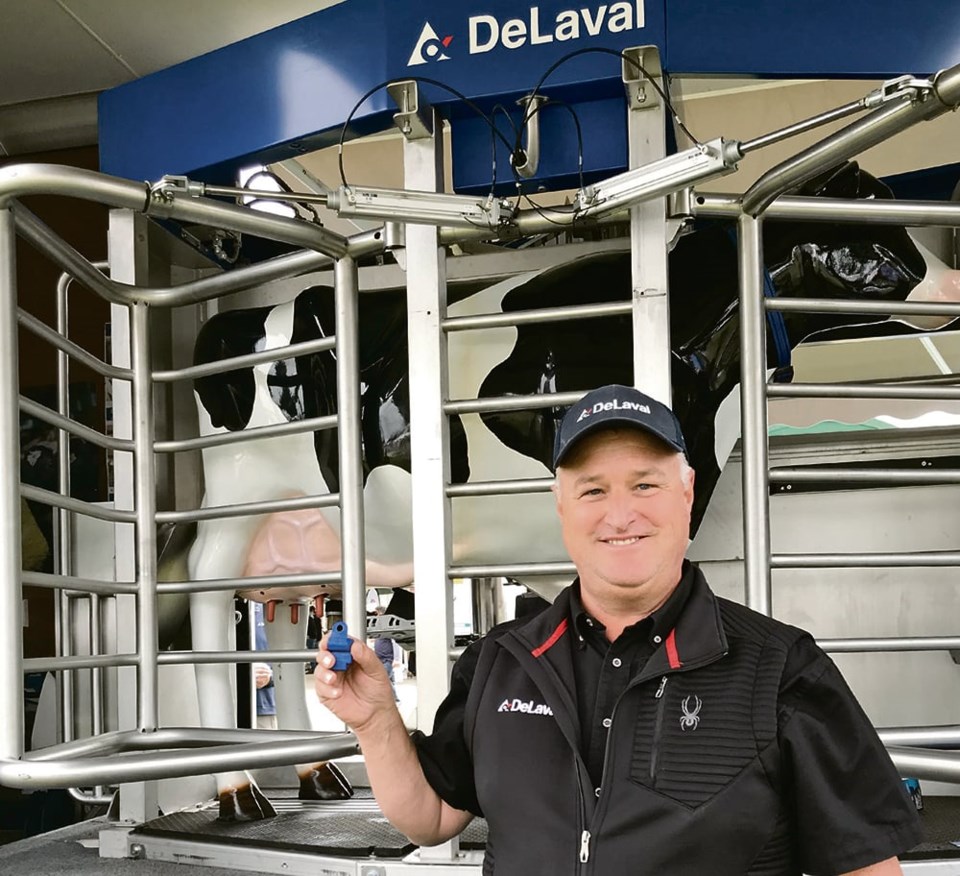WESTERN PRODUCER — DeLaval has launched its Plus Behavior Analysis tool, designed to monitor cow behaviour and herd health.
The company’s North American business development manager, Sjenk Van Soelen, said the most significant enhancement is the near real-time nature of DeLaval Plus monitoring abilities.
Newly developed ear tags send updates to the barn computer and onto the DeLaval Plus cloud every 2.2 seconds. This compares to a current industry standard of every 15 minutes.
“You can walk to the cow in the barn in real-time with your phone and be within 10 millimetres of the cow. She hasn’t walked away and gone off to another pen by the time you get there,” Van Soelen said.
He held recently in Woodstock, Ont.
He said DeLaval Plus builds on the company’s Herd Navigator software partly by adding cow behaviour monitoring aspects to the existing health and reproductive parameters tracked through milk samples.
Herd Navigator monitors cows for ketosis and other metabolic diseases and can determine when cows are in heat, cystic or pregnant, by testing milk.
The company spent four years testing and refining the system.
Van Soelen said DeLaval strived to achieve real-time access to “show the public that we care about our animals.”
Farms may be getting larger and larger, with more animals in bigger barns, but consumers want to know that if a cow is sick or ready for calving, the farmer is still able to find her and provide care within minutes.
“Let’s face it, as a company, and as an industry, we need to show the public that we care. We ask the public to drink what we produce and eat what we produce. We need to follow through on what we say we’re going to do on our side,” he said.
For producers, represents a significant improvement over existing cattle-tracking sensor systems.
Jaclyn Riddell, who farms near Listowel, Ont., with her husband, Travis, said in a news release announcing the DeLaval system that “if the cow is not feeling well, the graph on the computer will tell us before we can see it.”
The Riddells milk about 90 cows in a sand-bedded free-stall barn with robotic milkers. They were recognized in 2022 as one of six Platinum Award winners in the 15th annual Excellence in Dairy Reproduction program presented by the U.S. Dairy Cattle Reproduction Council. As one of the DeLaval Plus system pilot herds in Ontario, they began using the system, including its state-of-the-art heat detection capabilities, about two years ago.
Van Soelen noted the Riddells won the award while competing against many barns across North America that rely more on reproductive hormones. He said he believes the DeLaval system played a big role in building the Riddells’ confidence in making reproduction decisions.
A lot of robotic herds may be satisfied with the level of data they get through Herd Navigator, but Van Soelen said many rotary or parlour setups could also be suited for it.
The ear tags are reuseable. When the animal is shipped, a clip system allows producers to remove the tag so it can then be applied to a heifer entering the herd.
“We could have come to the market with this four years ago, but we’ve been working on battery life, durability, ease of use. The last thing we want to have is for a bunch of producers to start using these tags and then find out they keep falling out or breaking.”
With its artificial intelligence components, the system is set up to learn from its interactions with a herd’s cows. With every piece of information sent to the cloud, the DeLaval Plus sensors should become more effective at identifying and interpreting each cow’s behaviour.
“And this is just the thin edge of the wedge. We know there’s so much more to learn,” Van Soelen said.
Bookmark SASKTODAY.ca, Saskatchewan's home page, at this link.




